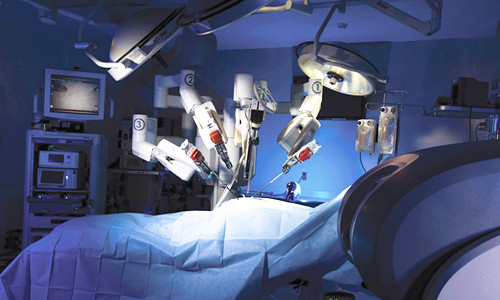Sensor-enhanced surgical robot enables highly precise and safe spinal operations
December 22, 2017
Source: medicalxpress
 736
736

Researchers from the University of Bern, Inselspital, Bern University Hospital and the Swiss Center for Electronics and Microtechnology develop a high-precision, sensor-based surgical robot for spinal operations together with industry partners. Their project is being funded with two million Swiss francs, sponsored by the "BRIDGE" programme of the Swiss National Science Foundation and the Commission for Technology and Innovation.
Within the scope of the project, titled "Towards Intelligent Sensor-enhanced Robotic Neurosurgery," Andreas Raabe from the Department of Neurosurgery at Inselspital and colleagues are developing a new sensor-enabled surgical technology which provides a new level of safety for complicated spinal operations.
Spine as "uneven terrain"
Manual spine stabilisation surgery is one of the most frequent back surgeries performed and numbers rising with an ageing population requiring more and more surgical procedures to address degenerative spine disease. The challenge of manual spine surgery using so-called pedicle screws to fuse and stabilise functionally unstable vertebrae is the "uneven terrain" of vertebral bone. The functional articulation of the human vertebral spine that confers lateral and rotational mobility, static stability and compressional strength is only possible because vertebrae have a complex shape and bone density composition. Drilling and positioning a screw into a highly variable part of the spine, whether manually or with image guidance technologies fails to be a success around 15 percent of the time. The screw misses the central part of the vertebrae and the sharp tip sticks out, in many cases to irritate surrounding tissue or nerves.
Perfect placement every time
Sensor-enabled surgical robotic drilling technology turns the variability of the vertebrae from a surgical challenge into the basis of precision surgical procedures. By using the complexity of vertebral anatomy like a "sensor map" the robotic drill is able to "feel" across the bone terrain and together with so-called Electromyography (EMG) neuromonitoring can avoid obstacles including nerves and boundaries of the bone. Thicker bone, thinner bone and nerves are sensed with super-human, robotic perception and verified at high speed with the relevant information from the imaging information that was established before the procedure. This way the surgical robotic technology potentially allows the neurosurgeon to place pedicle screws perfectly and with precision in every patient, every time.
The aim of this project is to introduce this augmented, robotic technology into the clinic and begin the process of clinical adoption of the next generation of neurosurgical interventions.
"For the first time the neurosurgeon has real-time data on where the drilling instrument is during the procedure and the surgical robot acts with supreme accuracy shutting down the drilling far sooner that a human operator could, thereby avoiding breakthrough or injury. This means potentially zero morbidity procedures with respect to pedicle screw misplacement. We see this as the future of spine surgery," commented Andreas Raabe.
"The use of EMG as a cross check control loop to give early warning on the proximity of nerve tissue and the overall integration of a sensor-driven surgical robotic system is a ground-breaking use of this technology in neurosurgery and will lead to many other clinical applications going forward," said Olivier Chételat. Neurosurgery is an integral part of the Swiss Institute for Translational and Entrepreneurial Medicine sitem-insel AG in Bern. This project represents a first promising cooperation with the CSEM in this area.
"We are honoured to have been selected in this first cohort of the "BRIDGE Discovery' call. It is testament to our research focus on clinical needs and the translation of biomedical research, a priority of Bern as a medical center. We are excited to introduce completely new technology concepts like EMG and force-density pose estimation into spine surgery for the first time. We believe that it is our duty to leverage new knowledge in biomedical engineering into surgical technology that brings the best possible clinical care to patients," said Stefan Weber.
By DduRead more on
- Things to Know before Buying Newborn Baby Incubators March 31, 2022
- Highly Resistant Food Poisoning Bug Responds to Antibiotics September 6, 2018
- Smartphone Based Diagnosis to Identify Mosquitoes Transmitting Infection September 5, 2018
- 3 Natural Plant Extracts Manufacturers on Drugdu.com September 4, 2018
- Shenzhen Chuanggan – Health Assessment Facility Supplier September 4, 2018
your submission has already been received.
OK
Subscribe
Please enter a valid Email address!
Submit
The most relevant industry news & insight will be sent to you every two weeks.



